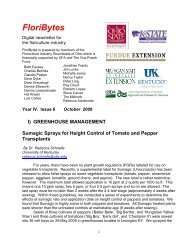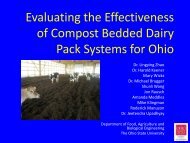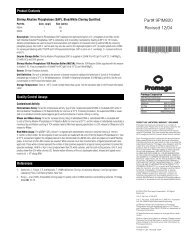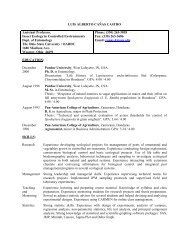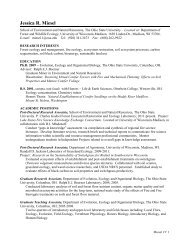GST Fusion Protein Production
GST Fusion Protein Production
GST Fusion Protein Production
Create successful ePaper yourself
Turn your PDF publications into a flip-book with our unique Google optimized e-Paper software.
12. Add DTT to 1mM and Triton X-100 to 1%.<br />
13. Incubate on ice 40min.<br />
14. Spin cell debris down at 20,000 X g (13,000 rpm in the Sorval SS34 rotor) for 20min.<br />
15. Collect the s/n and aliquot it away for storage at -80 o C.<br />
16. Determine the protein concentration by Bradford assay.<br />
17. Load 50-100µg of the crude E. coli protein extract onto a Laemmli protein gel.<br />
B. <strong>Protein</strong> Purification<br />
1. Prepare the glutathione agarose:<br />
(a) Weigh out the required quantity of glutathione agarose (Sigma cat# 4510).<br />
From a 500ml culture of <strong>GST</strong>-FUSION resuspended in 10 ml and French pressed, approximately 2mg of<br />
r<strong>GST</strong>-FUSION can be expected. Approximately 10mg of <strong>GST</strong> protein will bind to 1ml of swollen<br />
glutathione agarose. The required glutathione agarose bed volume is then only 250µL (Mao used 1.0 ml<br />
of the French Press lysate with 60µL of glutathione agarose beads). The small polypropylene columns<br />
hold approximately 2.5ml of settled bed resin, which can therefore be used to purify up to 25mg of target<br />
protein.<br />
(b) Add 1.0 ml sterile 1X PBS per 88mg of glutathione agarose. Alternatively add 10 ml of sterile 1X<br />
PBS to the entire vial of glutathione agarose (which if the vial states 10ml, that means there is 880mg in<br />
that vial).<br />
(c) Incubate at 4 o C overnight to swell the glutathione agarose. Unswollen glutathione agarose is stored at<br />
–20 o C but once it is hydrated do not freeze it. It is stable at 4 o C for ~ 1month. If longer storage is required<br />
add EtOH to 20%. Glutathione agarose is rather expensive so don’t waste it.<br />
Column Method:<br />
2. Thaw the E. coli protein extract on ice.<br />
3. Transfer the volume of swollen glutathione agarose to be used to a sterile polypropylene screw cap tube<br />
and equilibrate the glutathione agarose with 1X PGE- by adding 10X volumes of 1X PGE-. (If working<br />
with relatively small volumes of glutathione agarose and proteins extracts, then it may be easier to perform<br />
all of these steps in a microfuge tube.)<br />
4. Decant off the liquid fraction.<br />
5. Add the E. coli protein extract to the 1X PGE- equilibrated glutathione agarose. Incubate at 4 0 C with<br />
gentle shaking or rotation for ~90 min. Once the glutathione agarose is added to the column, allow it to<br />
settle by gravity. Open the column and allow the buffer to drain from the column. A flow rate of ~ 10<br />
column volumes per hour is supposedly optimal for efficient protein purification; too fast a flow rate will<br />
result in increased impurities in the eluted fraction.<br />
6. Wash the glutathione agarose resin with 10 volumes of 1X PGE+.<br />
7. Wash the glutathione agarose resin with 10 volumes of 1X PGE Wash Buffer. Repeat the wash for a<br />
total of three washes (1 wash with 1X PGE+ and 2 washes with 1X PGE Wash Buffer).<br />
Stockinger Lab; Version 02/16/01





